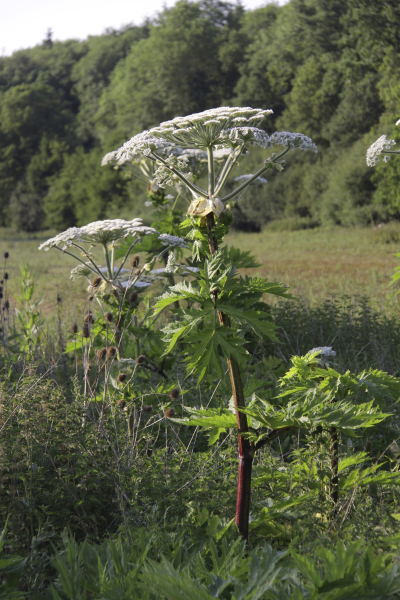 Giant hogweed – contact with this species can cause severe burns.
Giant hogweed – contact with this species can cause severe burns.Recently, Japanese knotweed has been discussed widely due to fresh research on the impact of the species; studies have found that in the property industry, it does not cause as much damage as has been believed for years. Giant Hogweed, however, presents much different discussions – whilst the discourse surrounding both species is considerably hysterical, for Giant Hogweed, this is because quite simply, the species presents a threat to human health – Japanese knotweed does not. In fact, Japanese knotweed has even been hailed as a rhubarb-y, anti-oxidant rich vegetable that goes nicely in a crumble!
This week, reports of a teen in Virginia, US, shocked the media.[1] The seventeen-year old had to be transferred to a specialist burns unit, demonstrating just how serious the effects of Giant Hogweed are – he suffered third degree burns, from a plant?! The sap of the plant contains chemicals called furanocoumarins, and when in direct contact with the skin, in conjunction with sunlight, an intense condition occurs – blisters and burns can last for months, with sensitivity to sunlight lasting for years after the initial contact. Blindness can even occur from contact with the eyes.
Particularly noteworthy about this incident, is that this was reportedly the state of Virginia’s first recording of the species – Giant Hogweed is so problematic not only due to its risks to public health, but due to its highly invasive nature; the plant is widespread across the UK after being introduced from the Caucasus region in the nineteenth century, in much the same way as Japanese knotweed – the plant was deemed an ornamental marvel with its large clusters of white flowers. Biodiversity is decreased wherever it chooses to tower – it relentlessly outcompetes native flora, and like its fellow non-native invasive plant, Himalayan balsam, can cause river bank erosion when it dies back, and creates flood risks if the dead vegetation impedes river flow.
How can we raise awareness of this harmful species? It seems that many articles reporting people being burned by Giant Hogweed, did not know what they had accidentally bumped into, and after the event, did not know what was to come. Giant Hogweed is listed under the Wildlife and Countryside Act 1981 (rev. 2) Schedule 9; this means that it is an offence to plant the species or otherwise cause it to spread in the wild. Councils provide information on the species and the dangers associated with it, but awareness seems to be garnered through the tales of extreme burns – after someone has been hurt by the plant. So, could the media frenzy surrounding Giant Hogweed actually be of use with this species? As already discussed, Japanese knotweed does not pose a public health threat; perhaps the reporting of Giant Hogweed injuries is the best way to create awareness and in turn, action?
[1] https://www.independent.co.uk/news/world/americas/giant-hogweed-burns-virginia-alex-childress-poisonous-effects-toxic-plant-a8450226.html
Lauren Tomlinson
Sales Support Executive, Ebsford Environmental Ltd






